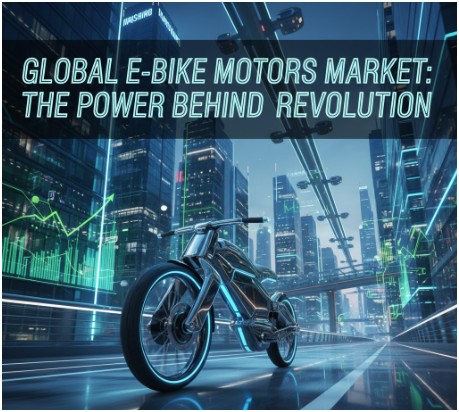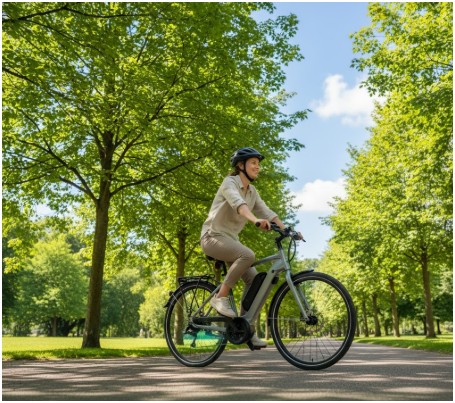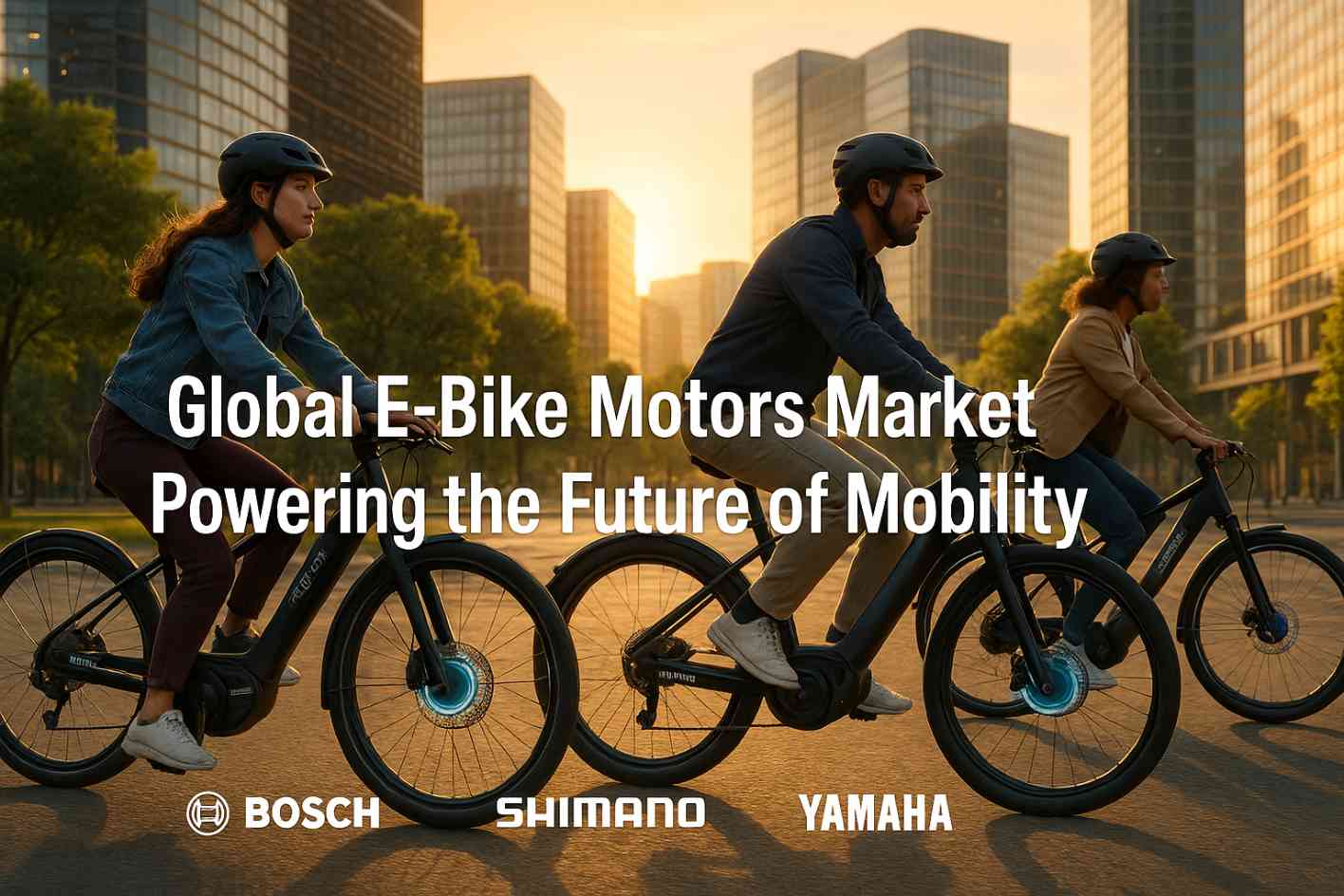A few summers ago, I rented an electric bike for a quick city ride. Within minutes, I was zipping past traffic, feeling like I’d discovered the future of commuting. That single experience turned me into a bit of an e-bike evangelist—and since then, I’ve been following the global e-bike motors market closely. What started as a niche hobby has now become one of the fastest-growing segments in the mobility world.
Today, e-bikes aren’t just eco-friendly toys for tech enthusiasts; they’re powerful machines transforming how we move, explore, and even work. And at the heart of it all? The motor—an unsung hero of this two-wheeled revolution.
What’s Driving Growth in the Global E-Bike Motors Market?

The numbers are pretty wild. The global e-bike motors market is on track to hit roughly $8.27 billion by 2028, with an impressive CAGR of 14.8%. It’s not just about people wanting to go green—it’s also about practicality.
Rising fuel prices and growing environmental awareness have made electric mobility an attractive solution for everyday riders. Plus, governments are getting serious about sustainable transport.
Across Europe and North America, you’ll find subsidies for e-bike purchases, better cycling infrastructure, and campaigns encouraging eco-commuting.
But what really stands out to me is how technology is keeping up with this growth. From smarter control systems to improved torque sensors, e-bike motors are evolving fast. The ride feels smoother, quieter, and a lot more powerful than it did even five years ago.
Why Are Mid-Drive Motors Winning the Race?
If you’ve ridden both a hub motor and a mid-drive motor, you’ll know the difference instantly. The mid-drive design feels balanced and powerful, especially on hilly terrain. And apparently, the rest of the world agrees—mid-drive motors are stealing the spotlight in the global e-bike motors market.
These motors sit at the center of the bike, distributing weight evenly and improving traction. They also make maintenance easier and enhance energy efficiency, which means longer rides without running out of juice halfway home.
Traditional hub motors still have their place, especially for budget-friendly models, but the market’s shifting. Mid-drive motors are fast becoming the standard for both performance and comfort-focused e-bikes.
Here’s a quick comparison to show why they’re gaining so much ground:
| Feature | Hub Motor | Mid-Drive Motor |
| Power Efficiency | Moderate | High |
| Weight Distribution | Rear/Front-heavy | Perfectly Balanced |
| Hill Climbing | Average | Excellent |
| Maintenance | Simple | Moderate |
| Cost | Lower | Higher |
I’ve tried both, and trust me—once you ride a mid-drive, it’s hard to go back.
How Are Technology and Comfort Fueling Market Momentum?

One of the coolest trends in the global e-bike motors market is the rise of “connected bikes.” These aren’t your grandpa’s bicycles—they come with built-in GPS, smartphone pairing, and even real-time diagnostics. You can literally check your bike’s performance from your phone like a Tesla dashboard.
Manufacturers are also obsessed with battery efficiency. Modern e-bikes can go 70–100 miles on a single charge, and charging times are shrinking every year. Motor controllers are smarter, optimizing torque and speed without draining the battery too fast.
And then there’s comfort—something people underestimate. Suspension systems are improving, frames are becoming lighter yet sturdier, and user ergonomics are a big deal now. Even if you’re not an athlete, you can ride long distances comfortably without feeling sore or drained.
Which Regions Are Leading the Charge?
Asia-Pacific remains the beating heart of the global e-bike motors market. Countries like China, Japan, and India dominate both production and consumption. It’s easy to see why—massive urban populations, high fuel costs, and a growing middle class looking for affordable mobility solutions.
Europe, especially Germany, has also carved out a large slice of the e-bike pie. The continent’s commitment to reducing emissions and promoting cycling infrastructure makes it the perfect market. In fact, cities like Amsterdam and Berlin are practically powered by pedals.
Meanwhile, North America is catching up fast. The pandemic nudged many commuters to ditch crowded public transport, and now e-bike sales in the U.S. are booming. As more states offer tax credits for electric mobility, the demand is expected to soar.
Who Are the Big Players Dominating the Market?

While the global e-bike motors market is fragmented, a few heavyweights keep showing up in every industry report. I’m talking about names like Bosch, Panasonic, Shimano, Yamaha, and Bafang.
Bosch stands out for its innovation and reliability. Their drive units are practically the gold standard in Europe. Shimano, known for its cycling heritage, brings that same precision to its e-bike systems. Yamaha continues to impress with powerful yet lightweight motors that make steep climbs effortless.
Then there are fast-rising brands like Dapu Motors, Xin Da Yang, and Ananda, especially strong in the Asian market. Together, these players are pushing innovation and keeping competition fierce—a win for riders like you and me.
How Is the E-Bike Revolution Changing Daily Life?
What I love most about this industry isn’t just the technology—it’s the lifestyle shift. More people are swapping their cars for e-bikes, rediscovering their cities, and embracing fitness again. It’s sustainable mobility that actually feels good.
Plus, e-MTBs (electric mountain bikes) are exploding in popularity. Whether you’re tackling rugged trails or weekend adventures, these bikes give you the boost to climb higher and ride longer.
In many ways, e-bikes are rewriting what “transportation” means. They’re not just a trend—they’re a movement.
FAQ: What People Are Asking About the Global E-Bike Motors Market
1. What’s the projected size of the global e-bike motors market by 2028?
The market is estimated to reach $8.27 billion by 2028, growing at a 14.8% CAGR. That’s massive growth driven by sustainability goals, fuel prices, and evolving tech.
2. Why are mid-drive motors becoming more popular than hub motors?
Mid-drive motors provide better balance, torque, and climbing ability. They also deliver smoother power transfer, making rides more natural and efficient—especially on steep or uneven terrain.
3. Which countries lead the e-bike motor market?
China, Germany, and Japan lead in production and usage, while the U.S. is rapidly growing thanks to government incentives and an increased focus on green commuting.
4. Who are the top companies in the global e-bike motors market?
Bosch, Panasonic, Shimano, Yamaha, and Bafang are the biggest players, known for quality, reliability, and constant innovation in motor performance and connectivity.
So, Where Do We Go From Here?
If you ask me, the global e-bike motors market isn’t just about business—it’s about transformation. Every ride, every motor upgrade, and every policy shift takes us closer to a world where clean mobility is the norm, not the exception.
I’ll admit—I still get a thrill every time I hop on an e-bike and feel that silent surge of power. It’s like getting a glimpse of a smarter, cleaner future—one pedal at a time.
So, if you’ve been thinking about joining the e-bike revolution, there’s never been a better time. Your wallet, your health, and the planet will thank you.







